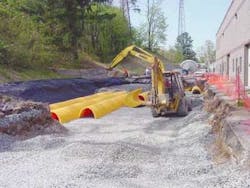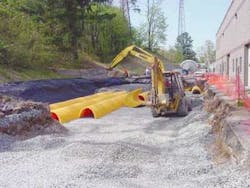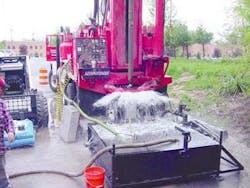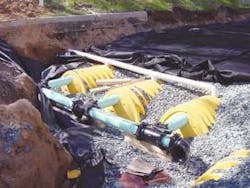Lab's Cooling System Improves Efficiency, Environmental Impact
By Daniel Lang and Geoffrey C. Horine
Albany Molecular Research, Inc. (AMRI), a pharmaceutical research and development company and one of the fastest-growing businesses in the New York Capital Region, needed an alternative cooling system to handle the extraordinary cooling needs of the 128,000-square-foot building housing its expanding organic chemistry laboratories.
Experiments conducted by chemists and lab technicians in this building involve the use and handling of potentially harmful chemicals, requiring the operation of hundreds of fume hoods. This creates high cooling demands: up to 1,000 tons of air conditioning load during peak periods in the summer.
AMRI was concerned about both energy efficiency — a conventional system would have required cooling towers, involving costly, high electricity and water usage — and environmental impacts — the facility's location adjacent to the protected Pine Bush Nature Preserve made it aesthetically undesirable to construct tall cooling towers. Malcolm Pirnie, Inc. together with Friedman Fisher Associates, assisted AMRI with a successful solution that addressed both technical and financial issues.
Recognizing the potential of using the local groundwater resource for cooling to lower energy demand and avoid potential environmental impacts, AMRI wanted to evaluate the aquifer's capacity to support a groundwater cooling system. With the goal of determining the most efficient configurations of groundwater extraction and recharge systems, Malcolm Pirnie performed a groundwater resource assessment, including drilling observation and pumping wells, and developed an innovative three-dimensional groundwater model to simulate different well and infiltration gallery configurations under a range of outside weather conditions.
This conceptual design was used to perform an economic analysis that compared energy efficiency and life cycle costs, including capital cost and energy usage, against those of a conventional cooling tower system. This analysis determined the groundwater cooling system would save approximately 352,000 kWh/year compared to a conventional system, equivalent to an eight-year capital investment payback. Based on the results of energy savings evaluations conducted by the consultants, AMRI obtained $400,000 in funding from the New York State Energy Research and Development Authority (NYSERDA), which supports the efforts of commercial customers to develop innovative, energy-efficient and renewable energy systems. These grants covered study expenses and offset the construction cost of the new facilities.
Malcolm Pirnie teamed with Friedman Fisher to design an open loop, non-contact geothermal cooling system – the first of its kind using groundwater as condensing water in a centrifugal chiller with an intra-aquifer "open-loop" recycling system to cool the heated water and replenish the water supply.
Groundwater, with a relatively constant temperature of 52 degrees F, is pumped to chillers, with up to 500-tons of cooling capacity each. Because the temperature differential in the chillers is maintained at about 35 degrees F, groundwater cooling is approximately 40 percent more efficient than conventional methods. Discharge water is then recycled to the aquifer via an upgradient infiltration gallery, constructed under the facility's parking lot, and cools before reaching the pumping wells.
Pumping rates are regulated based on load and discharge water temperature from the chillers' condenser using a programmable logic control system connected to AMRI's local area computer network for operational and maintenance efficiency.
The water supply piping, chiller controls, and infiltration gallery were designed for up to 800 gpm of groundwater pumping. This system will supply the necessary cooling demand once the entire 128,000-square-foot building is renovated into laboratory space. The current system in operation consists of five pumping wells supplying up to 500 gpm for cooling in three-quarters of the building. Once the fourth and final phase of expansion is completed, additional wells will be installed and the second chiller will be added to meet the estimated cooling demands for the entire facility.
This project demonstrates that non-conventional, groundwater source cooling systems can be used in lieu of conventional systems that are less energy efficient and less environmentally friendly. Conventional cooling towers of the size required for this project create long-term visual and noise impacts, require much more electricity and use more than one million additional gallons of water per year than the groundwater cooling system.
A conventional system for this facility would use an estimated 923,000 kWh/year, compared to 571,000 kWh/year for the groundwater cooling system, saving about 352,000 kWh/year – for an annual savings of approximately $35,000. While the estimated cost of constructing the groundwater system was about $275,000 more than a conventional system – normally a payback period of about eight years – the grant from NYSERDA offset the extra capital construction costs. NYSERDA also co-sponsored the project studies.
Successfully implementing this project involved correct decisions on various critical factors – the most effective configuration of groundwater extraction wells and infiltration trenches for the non-contact cooling water and selection and control of appropriate pumping rates to assure an adequate supply of groundwater.
A groundwater model developed by Pirnie estimated that 45-50 days were required for recharged water to travel from discharge to recovery wells.
The use of relatively cold ground water (compared to conventional cooling tower condenser water temperatures) resulted in extremely low flows through the centrifugal chiller condenser barrel. To accommodate this requirement, the chiller was specified with upgraded controls and tubing including a custom exterior enclosure housing the variable-speed drives and programmable logic controllers positioned near the well pump motors to limit harmonic disturbance. Control system operations were sequenced to stage pumps on and off and control speeds to maintain the highest possible discharge temperature, thus minimizing the required groundwater flow. Controls also incorporate water level sensors in the well to limit draw down and provide for a safety low water level trip.
About the Authors:
Daniel Lang is a hydrogeologist for Malcolm Pirnie, Inc. in Albany, NY. He manages water supply investigations, groundwater modeling and aquifer protection studies, and hazardous waste site projects. Geoffrey Horine is the Facilities Manager for Albany Molecular Research, Inc. in Albany, NY. He is responsible for overall facilities operations at Albany Molecular's campuses in the Albany area.



